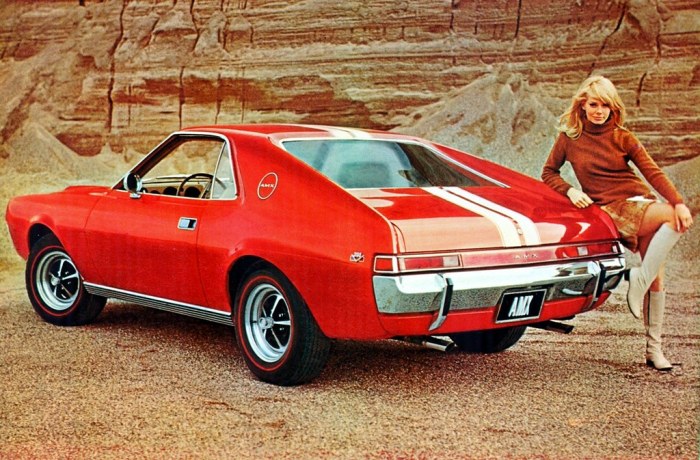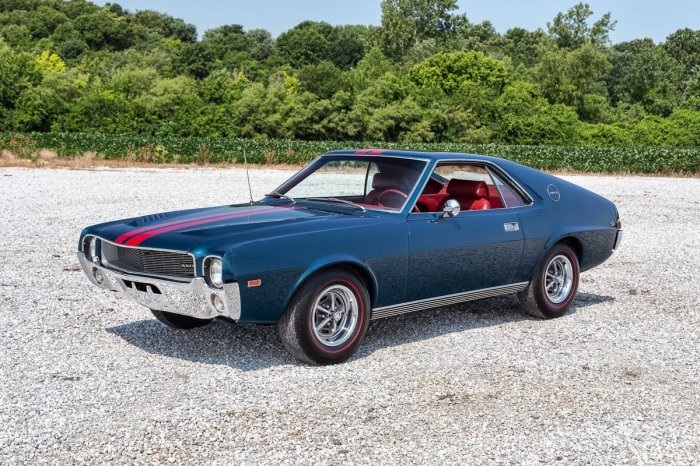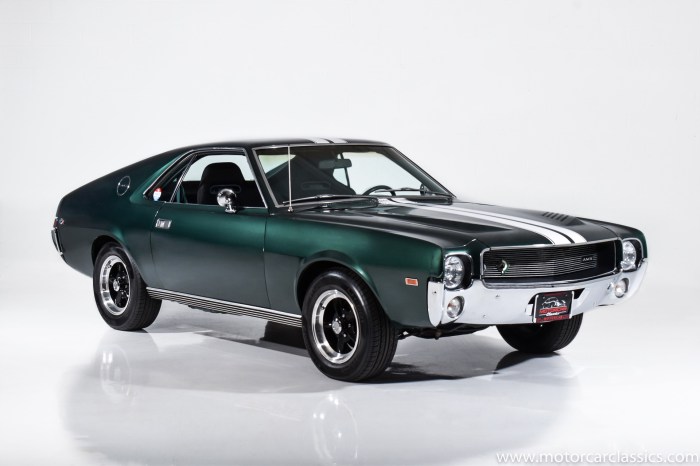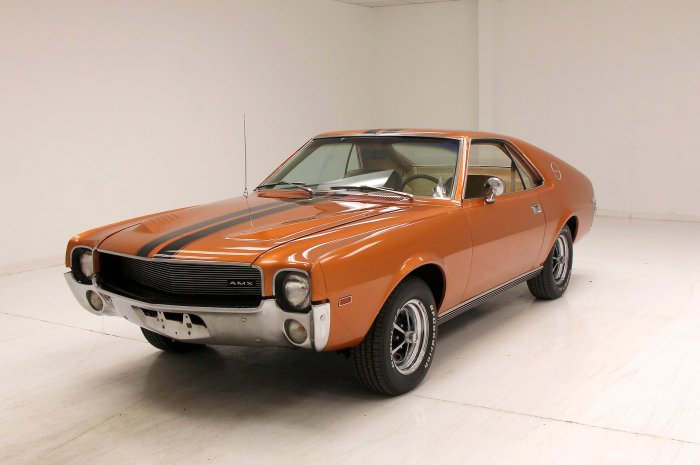The 1968 AMC AMX, a groundbreaking muscle car that redefined American automotive performance, emerged during a golden era of horsepower and daring design. This two-seater sports car, a bold departure from the norm, challenged the established muscle car giants with its sleek European-inspired styling, powerful engine options, and nimble handling.
The AMX’s arrival signaled a shift in the muscle car landscape, proving that power and performance could be packaged in a sophisticated and stylish package.
American Motors Corporation (AMC) aimed to create a car that could compete with the likes of the Ford Mustang and Chevrolet Camaro, but with a distinct personality. The AMX, with its low-slung profile, muscular lines, and distinctive fastback design, achieved just that.
It was a car that appealed to both performance enthusiasts and those who appreciated elegant design, showcasing AMC’s innovative approach to the muscle car genre.
The 1968 AMC AMX: A Rebellious Muscle Car

The 1968 AMC AMX, a two-seater sports car produced by American Motors Corporation (AMC), was a bold statement in the American muscle car era. It was a radical departure from AMC’s traditional offerings, and its sleek design and powerful engine captivated the hearts of performance enthusiasts.
The AMX’s arrival marked a turning point for AMC, showcasing its ability to compete with the established Detroit giants.
The Historical Context of the AMX
The 1968 AMC AMX was launched during a time when American muscle cars were at their peak. The “muscle car” phenomenon, fueled by the post-war economic boom and a growing demand for performance vehicles, was in full swing. Automakers like Ford, Chevrolet, and Plymouth were churning out powerful and stylish cars that captured the imagination of young drivers.
The 1968 AMC AMX, a groundbreaking muscle car, was a testament to American Motors Corporation’s ambition to carve a niche in the performance market. The AMX was a direct descendant of the earlier, somewhat more sedate, 1965 AMC Marlin , which itself was a daring attempt to break into the burgeoning personal luxury car segment.
While the Marlin may have been a bit too conservative for its time, the AMX perfectly captured the spirit of the muscle car era, and it remains a highly sought-after classic today.
AMC, however, was a relative newcomer to the muscle car game. The company had been struggling to find its place in the competitive American automotive market.
The Design and Engineering of the AMX
The AMX’s design was a collaboration between AMC’s in-house design team and the renowned Italian design house, Pininfarina. The result was a sleek and aerodynamic coupe with a distinctive fastback profile. The AMX’s low-slung stance and aggressive lines conveyed a sense of power and purpose.
The car’s compact dimensions and lightweight construction contributed to its agility and handling prowess.
The AMX’s Engine and Performance
Under the hood, the AMX was powered by a 390 cubic inch (6.4 L) V8 engine, which produced 315 horsepower. The engine was paired with a three-speed automatic transmission or a four-speed manual transmission. The AMX’s impressive power-to-weight ratio enabled it to achieve a top speed of over 120 mph and a 0-60 mph time of under 7 seconds.
The AMX’s Legacy, 1968 AMC AMX
Despite its short production run, the 1968 AMC AMX left an indelible mark on automotive history. It proved that AMC could compete with the established muscle car giants. The AMX’s unique design, powerful engine, and impressive performance made it a desirable and collectible car.
The AMX’s legacy continues to inspire car enthusiasts today.
Design and Styling

The 1968 AMC AMX, a groundbreaking muscle car, was not just about power; it was a statement of design and style. It boldly challenged the established muscle car formula with its sleek, European-inspired aesthetics, setting itself apart from the bulky, chrome-laden American muscle cars of the era.
Distinctive Design Features
The AMX’s design was a departure from the traditional American muscle car aesthetic. Its low-slung profile, fastback roofline, and sharp, angular lines were a stark contrast to the more rounded and bulky designs of its competitors. The car’s distinctive styling was the result of a collaboration between American Motors Corporation (AMC) and Italian design house, Pininfarina.
The AMX’s design was inspired by the European sports cars of the day, such as the Ferrari 250 GTO and the Alfa Romeo Giulia Sprint GT. This influence is evident in the car’s sleek lines, fastback roofline, and low-slung stance.
- Fastback roofline: The AMX’s fastback roofline was a unique design feature that gave the car a sleek and aerodynamic profile. It also provided a spacious interior for two passengers.
- Low-slung stance: The AMX’s low-slung stance was another key design element that gave the car a sporty and aggressive look. It also contributed to the car’s excellent handling.
- Sharp, angular lines: The AMX’s sharp, angular lines were a departure from the more rounded and bulky designs of other muscle cars of the era. This gave the car a modern and sophisticated look.
- Hidden headlights: The AMX’s hidden headlights were a unique design feature that gave the car a clean and aerodynamic front end. The headlights were concealed behind a retractable panel, which gave the car a sleek and modern look.
- Small, compact dimensions: The AMX was a relatively small and compact car, which made it agile and fun to drive. It was also easy to park and maneuver in tight spaces.
Comparison to Other Muscle Cars
Compared to its American muscle car counterparts, the AMX was a more refined and sophisticated machine. Its sleek lines, European-inspired styling, and focus on performance and handling made it a distinct alternative to the big, heavy, and often gaudy muscle cars of the era.
- Ford Mustang: The Ford Mustang, a popular muscle car of the era, was known for its sleek and sporty design. However, it was a larger and more traditional muscle car than the AMX. The Mustang had a more rounded body, a longer wheelbase, and a more spacious interior.
- Chevrolet Camaro: The Chevrolet Camaro, another popular muscle car of the era, was also known for its sleek and sporty design. However, it was a larger and more powerful car than the AMX. The Camaro had a more traditional muscle car look, with a longer hood, a shorter rear deck, and a more aggressive stance.
- Plymouth Barracuda: The Plymouth Barracuda, a competitor to the AMX, was also a relatively small and sporty muscle car. However, it was not as sleek or refined as the AMX. The Barracuda had a more traditional muscle car look, with a longer hood, a shorter rear deck, and a more aggressive stance.
The 1968 AMC AMX was a muscle car that offered a potent blend of performance and style, setting the stage for AMC’s later foray into more compact offerings. The 1975 AMC Gremlin, a smaller, more fuel-efficient model , reflected a shift in consumer preferences towards practicality, a trend that ultimately led to the demise of the AMX.
However, the AMX’s legacy lives on as a testament to AMC’s commitment to innovation and performance, even in a changing automotive landscape.
Performance and Handling

The 1968 AMC AMX, a compact muscle car, was engineered for both thrilling performance and responsive handling. Its powerful engine options and carefully designed chassis provided a driving experience that was both exhilarating and controllable.
Engine Options and Performance Characteristics
The AMX was offered with two engine options: a 390 cu in (6.4 L) V8 producing 315 hp (235 kW) and a 343 cu in (5.6 L) V8 producing 280 hp (210 kW). The 390 engine, available in both 2-barrel and 4-barrel configurations, delivered impressive acceleration and top speed.
The 1968 AMC AMX was a groundbreaking muscle car that captured the spirit of the era. It was a stark departure from AMC’s previous image, which was largely defined by the more practical, economical 1962 AMC Rambler. While the Rambler was a family-friendly compact, the AMX was a pure performance machine, designed to take on the likes of the Ford Mustang and Chevrolet Camaro.
The 343 engine, while less powerful, offered a more fuel-efficient alternative. The AMX’s performance was impressive for its time. The 390-powered AMX could achieve a 0-60 mph time of around 7 seconds and a top speed of over 120 mph.
These figures were competitive with other muscle cars of the era, such as the Chevrolet Camaro and Ford Mustang.
Comparison to Competitors
The AMX’s performance compared favorably to its competitors. The 390-powered AMX was quicker off the line than the base-model Chevrolet Camaro and Ford Mustang, both of which were equipped with smaller V8 engines. However, the AMX’s top speed was slightly lower than that of the more powerful versions of these competitors.
Key Factors Contributing to Handling Capabilities
The AMX’s handling was a key factor in its overall appeal. AMC’s engineers designed the car with a low center of gravity and a stiff suspension, which contributed to its agility and responsiveness. The AMX also featured a rack-and-pinion steering system, which provided precise steering input.The AMX’s independent front suspension and rear leaf spring suspension system allowed for a balanced and predictable handling experience.
The car’s relatively lightweight design, compared to its competitors, also contributed to its agile handling.
Interior and Features
The 1968 AMC AMX, despite its compact size, offered a surprisingly spacious and comfortable interior for both driver and passenger. The focus was on functionality and performance, with a driver-centric cockpit that prioritized control and feedback.
Seating and Interior Design
The AMX’s interior was designed with a focus on performance and driver comfort. The bucket seats were firm and supportive, providing excellent lateral support during spirited driving. The dashboard was simple and functional, with large, easy-to-read gauges and a minimalist design.
The AMX’s interior was a departure from the plush, luxurious interiors of some of its muscle car rivals. It was more spartan, but it was also more focused on the driving experience. The AMX’s interior was a reflection of its rebellious spirit, a car that was more about performance than luxury.
Available Options and Accessories
While the AMX was a relatively basic car, several options and accessories were available to personalize the driving experience. These included:
- Air conditioning
- Power steering
- AM/FM radio
- Vinyl roof
- Various wheel options
These options allowed buyers to customize their AMX to their preferences, whether they wanted a more luxurious experience or a more focused performance machine.
Legacy and Impact
The 1968 AMC AMX, a groundbreaking muscle car that defied expectations, left an indelible mark on the automotive industry and cemented its place in automotive history. Its rebellious spirit, innovative design, and impressive performance made it a cultural icon, influencing both car enthusiasts and the broader public.
Impact on the Automotive Industry
The AMX’s influence on the automotive industry is multifaceted. Its sleek, aerodynamic design, a departure from the boxy muscle cars of the time, paved the way for future performance car aesthetics. The AMX’s success also demonstrated that a smaller, more agile car could compete with the larger, more powerful muscle cars from Detroit’s Big Three.
The AMX’s impact on the automotive industry can be summarized as follows:
- Pioneering Aerodynamics:The AMX’s sleek design, featuring a low profile and a fastback roofline, was a significant departure from the boxy muscle cars of the era. It showcased the potential of aerodynamic design for performance and efficiency, influencing future car designs.
- Challenging the Status Quo:The AMX’s success proved that a smaller, more agile car could compete with the larger, more powerful muscle cars from Detroit’s Big Three. It challenged the established muscle car formula, inspiring other manufacturers to explore alternative approaches to performance.
- Influence on Future Designs:The AMX’s design cues, such as its low profile, fastback roofline, and integrated rear spoiler, were adopted by other manufacturers and influenced the design of future performance cars.
Role in Pop Culture
The AMX quickly gained a cult following, appearing in popular culture, movies, and television shows, further solidifying its iconic status. Its rebellious spirit resonated with a generation that embraced individuality and challenged traditional norms. Here are some notable examples:
- “The Dukes of Hazzard”:The AMX made a memorable appearance in the popular television series “The Dukes of Hazzard,” further cementing its association with rebellion and high-octane action.
- “The Fast and the Furious”:The AMX’s iconic design and performance made it a popular choice for car enthusiasts, leading to its inclusion in the “Fast and the Furious” franchise, where it was driven by the character of Letty Ortiz.
- “American Graffiti”:The AMX’s presence in the classic coming-of-age film “American Graffiti” highlighted its role as a symbol of freedom and rebellion for a generation.
Influence on Other Muscle Cars
The AMX’s success inspired other manufacturers to explore alternative approaches to muscle car design and performance. Its influence can be seen in the development of other notable muscle cars, including:
- Ford Mustang:The AMX’s success helped to inspire the development of the Ford Mustang, which became one of the most iconic muscle cars of all time.
- Chevrolet Camaro:The AMX’s design and performance influenced the development of the Chevrolet Camaro, another iconic muscle car that challenged the dominance of Ford’s Mustang.
- Plymouth Barracuda:The AMX’s success also influenced the development of the Plymouth Barracuda, which was designed to compete directly with the AMX in the compact muscle car segment.
Technical Specifications

The 1968 AMC AMX was a marvel of engineering, packing a powerful punch in a compact package. Its technical specifications reflect the meticulous attention to detail that went into its creation, making it a standout performer on the track and the road.
Engine and Drivetrain
The AMX was offered with two engine options, both of which were designed to deliver impressive performance.
| Engine | Displacement (cu in) | Horsepower | Torque (lb-ft) |
|---|---|---|---|
| 390 cu in V8 | 390 | 315 hp @ 5000 rpm | 425 lb-ft @ 3200 rpm |
| 343 cu in V8 | 343 | 280 hp @ 4600 rpm | 350 lb-ft @ 3000 rpm |
Both engines were mated to a three-speed automatic transmission or a four-speed manual gearbox, allowing drivers to choose the driving experience that best suited their preferences.
Dimensions and Weight
The AMX was a compact muscle car, designed for agility and handling.
| Dimension | Measurement |
|---|---|
| Wheelbase | 102 inches |
| Length | 177.2 inches |
| Width | 71.8 inches |
| Height | 49.5 inches |
| Curb Weight | 3,200 lbs (390 engine) |
Performance Figures
The AMX’s performance was impressive for its time, showcasing its capability as a true muscle car.
| Performance | Measurement |
|---|---|
| 0-60 mph | 7.0 seconds (390 engine) |
| Quarter Mile | 14.8 seconds (390 engine) |
| Top Speed | 125 mph (390 engine) |
Visual Representations
The 1968 AMC AMX’s distinctive design is best understood through visual representations. These illustrations capture the car’s unique styling elements and its overall aesthetic appeal, highlighting the key design features that set it apart from its contemporaries.
Front View
The front view of the 1968 AMC AMX showcases its aggressive stance and low-slung profile. The prominent grille, featuring a horizontal bar with the AMC logo, is flanked by rectangular headlights. The long hood, with its distinctive power bulge, further emphasizes the car’s performance capabilities.
The absence of a traditional bumper, replaced by a simple chrome strip, adds to the car’s sleek and modern appearance.
Side View
The side profile of the 1968 AMC AMX reveals its fastback design, characterized by a sloping roofline that flows seamlessly into the rear deck. The long, low-slung body, with its pronounced wheel arches, further emphasizes the car’s sporty nature. The absence of door handles, replaced by flush-mounted buttons, enhances the car’s aerodynamic profile and contributes to its sleek aesthetic.
Rear View
The rear view of the 1968 AMC AMX showcases its distinctive taillights, housed in separate rectangular units on each side. The rear window, integrated into the sloping roofline, adds to the car’s aerodynamic profile. The simple, uncluttered design of the rear end further emphasizes the car’s clean and modern lines.
Interior View
The interior of the 1968 AMC AMX features a driver-focused cockpit, designed for both comfort and performance. The high-backed bucket seats, upholstered in vinyl or cloth, offer excellent support during spirited driving. The instrument panel, featuring a large speedometer and tachometer, provides essential information at a glance.
The simple, functional layout of the interior reflects the car’s focus on performance and driving experience.
Concluding Remarks: 1968 AMC AMX

The 1968 AMC AMX, a testament to American Motors Corporation’s daring vision and engineering prowess, left an enduring mark on the automotive world. Its unique blend of performance, style, and affordability made it a standout among its contemporaries, capturing the imagination of car enthusiasts and leaving a legacy that continues to inspire.
The AMX, a bold and unconventional muscle car, proved that American automotive innovation could challenge the established norms and redefine the boundaries of performance and design.